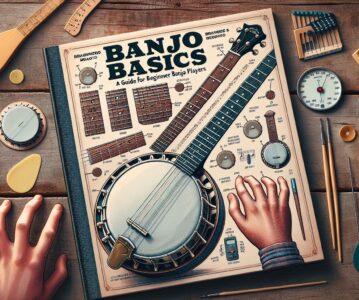The banjo is a unique and wonderful instrument that has captured the hearts of music lovers for centuries. Its distinctive sound and rich history make it an intriguing choice for musicians of all ages. If you’re a banjo beginner, this blog post is here to help you navigate the world of banjo playing. From understanding the different types of banjos to learning basic techniques, we will cover all the essential aspects to get you started on your banjo journey.
Introduction: What Makes the Banjo Special?
Before we dive into the specifics of playing the banjo, let’s take a moment to appreciate this fascinating instrument. The banjo is often associated with folk, bluegrass, and country music, but its roots go much deeper. Originating from West Africa, the banjo found its way to America through enslaved African people. Over time, it evolved and became an integral part of American folk culture.
One of the most popular and widely used banjos is the 5-string banjo. This type of banjo is characterized by its five strings, four of which are tuned to specific pitches, and the fifth string, known as the drone string, which adds a distinctive twang to the banjo’s sound.
Types of Banjos: Which One is Right for You?
Before you embark on your banjo journey, it’s essential to understand the different types of banjos available. While there are several variations, we will focus on the most common ones:
-
Open Back Banjos: These banjos have an open wooden back, which produces a softer and mellower sound. Open back banjos are often favored by old-time and clawhammer banjo players.
-
Resonator Banjos: Resonator banjos have a closed back with a metal plate, which gives them a louder and brighter tone. These banjos are commonly used in bluegrass music.
-
Tenor Banjos: As the name suggests, tenor banjos have four strings and are commonly tuned in fifths. They are popular in jazz and Irish music.
Getting Started: Banjo Essentials
Now that you have a better understanding of the banjo and its different variations let’s delve into the basics of playing this unique instrument:
1. Holding the Banjo:
Hold the banjo with your left hand against your chest, while the neck of the banjo is angled slightly upward. Rest your right forearm on the banjo’s rim to provide support while playing.
2. Tuning:
One of the critical steps for getting a pleasant sound out of your banjo is to ensure it’s properly tuned. The most common tuning for a 5-string banjo is known as “Open G” tuning (G D G B D), with the fifth string tuned to a higher pitch than the rest. Utilize a digital tuner or an online tuning app to help you achieve the correct pitch for each string.
3. Picking Techniques:
There are two primary picking techniques for the banjo: three-finger picking and clawhammer (frailing) style.
-
Three-Finger Picking: This technique involves using your thumb, index, and middle fingers to pluck the strings. Practice the basic rolls, such as the forward roll and the backward roll, to build dexterity and coordination.
-
Clawhammer Style: Clawhammer banjo playing involves striking the strings with the back of the fingernail or a finger pick. It produces a rhythmic, percussive sound. Experiment with the bum-ditty pattern, a fundamental clawhammer technique, to start building your repertoire.
4. Learning Chords:
Chords provide the harmonic structure for the music you’ll play on the banjo. Begin by learning basic open chords, such as G, C, and D. These chords will let you play many popular songs and give you a foundation to progress from.
5. Practicing Scales:
Scales are an essential tool for developing finger dexterity and understanding the banjo’s fretboard. Start by practicing the major and minor scales, paying attention to proper finger placement and coordination.
Conclusion: Embrace the Banjo’s Unique Sound
Congratulations on embarking on your banjo journey! Remember, learning to play any instrument takes time, patience, and practice. Explore different playing styles, experiment with various genres, and most importantly, have fun! As a beginner, the banjo can open up a world of creativity and musical expression. The banjo’s distinctive sound and rich heritage make it a joy to learn and play. So, pick up your banjo, string by string, and let the music come alive!
Note: This blog post provides a general overview to help beginner banjo players get started. Consider seeking out a qualified banjo instructor or online tutorials to further enhance your learning experience.


